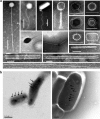Active and diverse viruses persist in the deep sub-seafloor sediments over thousands of years
- PMID: 30877284
- PMCID: PMC6776017
- DOI: 10.1038/s41396-019-0397-9
Active and diverse viruses persist in the deep sub-seafloor sediments over thousands of years
Abstract
Viruses are ubiquitous and cause significant mortality in marine bacterial and archaeal communities. Little is known about the role of viruses in the sub-seafloor biosphere, which hosts a large fraction of all microbes on Earth. We quantified and characterized viruses in sediments from the Baltic Sea. The results show that the Baltic Sea sub-seafloor biosphere harbors highly abundant viruses with densities up to 1.8 × 1010 viruses cm-3. High potential viral production down to 37 meters below seafloor in ca. 6000-years-old sediments and infected prokaryotic cells visible by transmission electron microscopy demonstrate active viral infection. Morphological and molecular data indicate that the highly diverse community of viruses includes both allochthonous input from the overlying seawater and autochthonous production. The detection of cyanophage-like sequences showed that viruses of phototrophic hosts may persist in marine sediments for thousands of years. Our results imply that viruses influence sub-seafloor microbial community dynamics and thereby affect biogeochemical processes in the sub-seafloor biosphere.
Conflict of interest statement
The authors declare that they have no conflict of interest.
Figures





References
-
- Parkes RJ, Cragg B, Roussel E, Webster G, Weightman A, Sass H. A review of prokaryotic populations and processes in sub-seafloor sediments, including biosphere:geosphere interactions. Mar Geol. 2014;352:409–25. doi: 10.1016/j.margeo.2014.02.009. - DOI
Publication types
MeSH terms
LinkOut - more resources
Full Text Sources
Other Literature Sources

